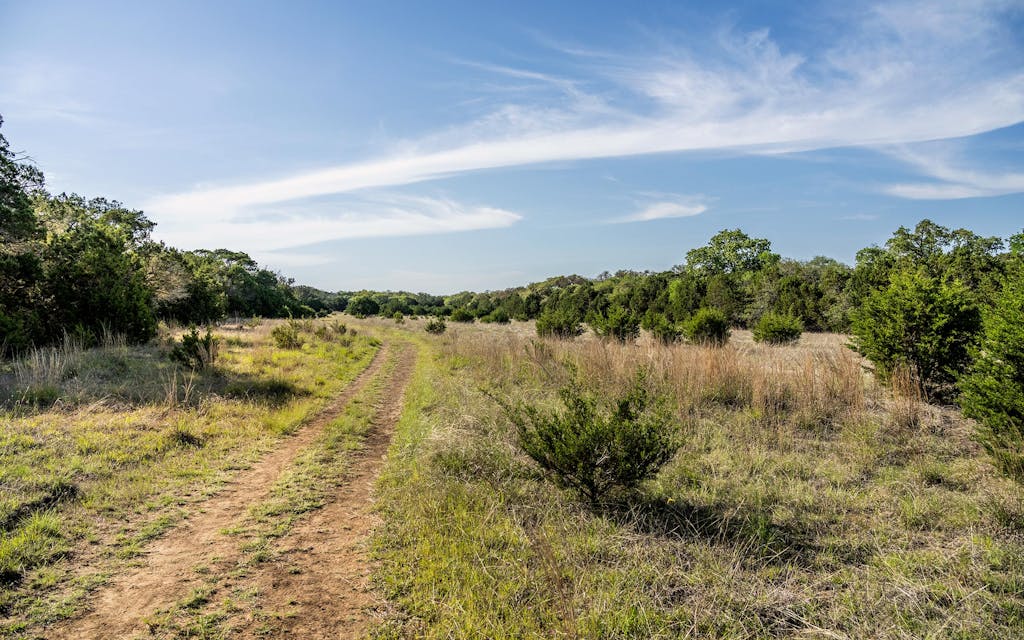Sometimes the easy park gives you the most trouble. You expect challenges at a place like far-flung Bentsen–Rio Grande Valley State Park, at the very southern edge of the state, where I and my trusty sidekick, Emily, spent a dark night in a lonely tent within earshot of the Rio Grande at an otherwise deserted campground. Or Big Bend Ranch, in far West Texas, where reaching our ridiculously remote campsite required a bone- and nerve-rattling journey through unforgiving desert. But during our most recent attempt at mild-mannered adventure, it was laid-back, family-friendly Guadalupe River State Park that thwarted us at every turn.
A peaceful Hill Country treasure, the park is a mere forty miles north of San Antonio and eighty southwest of Austin. And it couldn’t be more inviting: 1,938 acres of rolling green hills studded with limestone rocks and blanketed in patches of oak and juniper trees. Four miles of the clear Guadalupe River flow between craggy, cactus-sprouting cliffs and venerable bald cypress trees that stand half in and half out of the water, their feathery green arms a shady shelter and their knobby knees a makeshift perch.
It wasn’t the park’s fault, really, that things didn’t go as planned. Alas, Texas weather is capricious. On our first attempt, last September, days of rain nixed our camping plans, turned the usually crystalline Guadalupe cloudy, and closed the trails, including those in the park’s adjacent Honey Creek State Natural Area, 2,300 pristine acres accessible only by guided tour. On good days, Guadalupe River State Park’s thirteen miles of trails welcome hikers, bikers, and horseback riders (BYOH), but inclement weather can limit access. The trail closures are intended to minimize erosion, but I imagine they’re also meant to head off mishaps such as the one I brought upon myself while exploring Wagon Ford, a secluded, tree-shaded campground of nine sites set above a rock-strewn stretch of the Guadalupe. Succumbing to the siren song of rapids below, I set out on a so-called social trail leading to the river, slipped in the mud, and slid down the hill, Romancing the Stone–style, while Emily calmly looked on from above. We decided then and there that this trip was a wash, so to speak, and we’d return in the spring.


Seven months later, we arrived at the park on a weekday, which meant that, once again, we’d be unable to hike in Honey Creek (tours take place on Saturday). We also missed out on the weekends-only Discovery Center, which offers youngsters (and clueless writers) hands-on, “skins, skulls, skeletons” lessons on park flora and fauna. But, hey, at least this time the river was running and the sun was shining. Too bad temperatures hovered at that not-sweet spot (for us, at least), where they were just a little too low for soaking in the river and a little too high for hiking.
We hiked (more like huffed and puffed) anyway, heat be damned. We headed out on the Bamberger Trail, in a section of the park north of the river called the Bauer Unit, named for the sturdy German couple who established a farmstead there in the mid-1800s, had five children, and more than likely didn’t do much whining. At 670 acres, the Bauer Unit is a less-visited, more primitive space (no amenities or facilities) linked by eight miles of trails that draw seekers of solitude and the kind of quiet that allows for detecting the calls of endangered golden-cheeked warblers who nest in the area’s dense stands of Ashe juniper. The trails cover a lot of ground, but a shortish option is to take the Bamberger Trail to where it meets the Curry Creek Overlook Trail and hike that till you’re ready to turn around (if you want to make a loop, there’s a 3.5-mile option). You’ll walk through an olive-hued sea of native prairie grass hedged by a deep-green tree line and clear blue sky, a scene worthy of a Julian Onderdonk painting, then traverse a rugged trail that wanders through a fairy-tale forest of hardwood trees draped in Spanish moss, past fossil-studded rock outcroppings, and onto a ridge overlooking the trail’s namesake stream.
The adjoining trail is named for J. David Bamberger, the cofounder of Church’s Chicken, who spent decades turning a neglected and abused patch of land near Johnson City into a model of Hill Country conservation, the Bamberger Ranch Preserve, a.k.a. Selah. He also owned most of the land that would become the Bauer Unit from 1971 to 1974, when he sold it, at a discount, to the state parks department, which, according to writer John Jefferson in Texas Parks & Wildlife magazine, had to fend off opposition to the creation of a riverside park from local landowners, who worried that it would “bring in hippies.”
Bat Signals
The park occasionally hosts Bat Walks, a kid-friendly experience that includes an after-dark stroll to the water. There, a park interpreter can identify the types of bats flying overhead by using a nifty tablet app with an ultrasonic microphone to record their calls.
You can get to the river from the Bauer Unit, but you’ll have to travel either four or six miles round-trip. As Mr. Bamberger, who turns 93 in June, has been quoted as saying, “Do not initiate an action you are not willing or capable of sustaining.” There’s a better, if more popular, way to access the park’s main attraction, and that’s the half-mile Bald Cypress Trail, which hugs the shady southern banks of the Guadalupe and passes through the lovely day-use area, where a grassy area outfitted with grills and picnic tables gives way to a rocky shore fronting the wide expanse of blue-green river. If you happen to notice one of the “Respecting the River” welcome signs, stop to note the useful admonitions (the river can be unpredictable and also please don’t put diapers in it) as well as the hilariously explicit illustrations warning against bad behavior—they feature swimsuit-clad figures variously crying, getting handcuffed, and being loaded into an ambulance.
Fortunately, during quieter times of the year, you’re less likely to encounter a summer bacchanal than couples relaxing in partially submerged camp chairs, kayakers gliding by, fishers in waders patiently stalking catfish or Guadalupe bass, and birdwatchers training their binoculars on the cliff swallows that dart in and out of their nests in a limestone bluff on the opposite side of the river.
Even if the day-use section is crowded, it’s not too hard to follow the river trail and find your own little patch of liquid real estate in which to swim or wallow or float. Be aware, though, that Nuestra Señora de Guadalupe, so named by Alonso de León 332 years ago, is always on the move, so anchor or tie up your raft or tube if you don’t want it to end up at Canyon Lake, which is the first major obstacle this untamed waterway encounters after running unobstructed from its origins west of Kerrville. The official park map notes, in deadpan fashion, “River does not flow in a circle. You will not come back around to the same place you put in.” It was probably for the best that we reluctantly decided that the water was too cold to get in. I would have likely tried to tube all the way to the last takeout point above Canyon Lake, about six hours and five-and-a-half miles downriver.

Emily and I were at least able to camp on our April visit, at the same Wagon Ford campground where I slid down the hill to the water. But, of course, when does camping ever go off without a hitch? Emily, at 8:30 p.m.: “Should we put the rain fly on?” Me: “Nah, man, the chances are, like, two percent!” Emily, at 2:51 a.m.: “Wake up. It’s raining.” This after I’d finally fallen asleep to the sounds of coyotes howling somewhere in the distance and armadillos rustling up grub just feet from my pillow. Fortunately, Emily is smarter than I am and had reviewed the instructions for how to put the rain fly on the tent, which she did efficiently and without complaint while I stood by and watched helplessly.
It occurred to me later that after a year in which a global pandemic had necessitated a life lived almost completely online, it perhaps wasn’t such a bad thing to slip in the mud and get rained on. And I realized that my favorite moments of our two attempts at enjoying Guadalupe River State Park were the simple ones, like resting on the banks of the river as the sun went down, listening to the water swirl and bubble over the stones and the toads belt out their soggy serenades. And sitting on a rock at our campsite and watching thousands of leaf-cutter ants valiantly hoist neat wedges of greenery many times their size and march in a disciplined line across the ground before they disappeared into their underground empire through a small hole wreathed by more freshly cut leaves. And studying the fragile fuchsia phlox that sprouted up on the Bamberger Trail and thinking that maybe, just maybe, after a year that had brought so much anxiety, it was okay to give in to the sheer optimism on display in the colorful blooms and cheerful birdsong and shiny, impossibly green new leaves, to revel in the reassuring way that nature just keeps on keeping on.
This article originally appeared in the June 2021 issue of Texas Monthly with the headline “Fair-weather Friend.” Subscribe today.
- More About:
- Parks & Recs
- San Antonio
- Hill Country









